A well-fitting coat is a status symbol, enhancing any outfit. This guide covers fit, styles, measurements, and fabric to help men choose the perfect coat confidently.
Importance of Proper Fit
A well-fitting coat is essential for both style and functionality. It enhances confidence, creating a polished appearance that elevates any outfit. Proper fit ensures optimal comfort and mobility while maintaining body heat and protecting against the elements. A coat that drapes correctly on the shoulders, chest, and body avoids boxiness, offering a tailored look. Ill-fitting coats can appear unflattering and unrefined. Prioritizing fit ensures a coat serves its purpose while making a strong fashion statement. It’s a key detail that reflects attention to personal style and sophistication.
Understanding Measurements and Sizing

Accurate measurements are the foundation of a perfect fit. Key measurements include chest circumference, shoulder width, and body length. These align with size charts to ensure a tailored look that allows freedom of movement without restriction. Always compare your measurements to the size chart before purchasing for the best fit.
How to Measure Yourself
To ensure the best fit, measure yourself accurately. Start with your chest: wrap a tape measure around the widest part, keeping it level and snug but not tight. Next, measure your shoulders from one tip to the other across the back. For sleeve length, measure from the base of the neck to your wrist with your arm slightly bent. Finally, measure your body length from the base of the neck to your desired coat length. Compare these measurements to size charts for an ideal fit.
Interpreting Size Charts
Understanding size charts is crucial for a perfect fit. Compare your measurements to the chart, focusing on chest, shoulder, and sleeve length. Sizes may vary slightly between brands, so check specific guidelines. Regular, slim, or relaxed fits are options; choose based on your body type. If layering, consider sizing up for comfort. Always review the chart before ordering to ensure the best fit for your measurements and desired style.
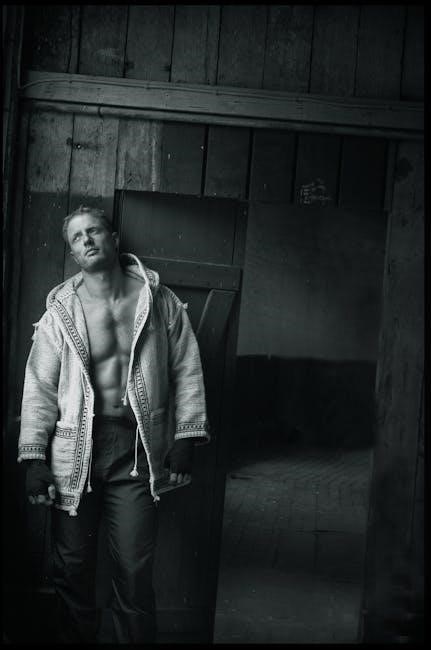
Coat Styles and Their Fit Characteristics
From tailored overcoats to casual pea coats, each style offers unique fit characteristics, ensuring versatility for different body types and personal preferences in men’s fashion.
Overcoats

Overcoats are designed for versatility, offering a sophisticated look while providing warmth. They typically hit just above the knee, balancing style and practicality. Tailored overcoats, like the British Warm, feature a structured fit, sitting smoothly over suits. The shoulders should align naturally, without excess fabric, ensuring a polished appearance. Ideal for taller men, overcoats elongate the silhouette, while shorter styles suit those preferring a more streamlined look. Pairing well with formal or casual attire, overcoats are a timeless wardrobe staple, blending functionality with refined aesthetics for any occasion.
Pea Coats and Trench Coats
Pea coats are short, double-breasted designs hitting just below the hips, ideal for shorter men. Trench coats, classic and versatile, combine functionality with style, often featuring belted waists and epaulets. Both styles emphasize clean lines and tailored fits, ensuring comfort and mobility. For shorter men, pea coats are perfect, while trench coats suit taller frames. Ensure the fit is snug but not restrictive, allowing layering without bulk. These coats are timeless, blending seamlessly into formal or casual wardrobes, offering a polished yet practical choice for any occasion.
Chore Coats and Field Jackets
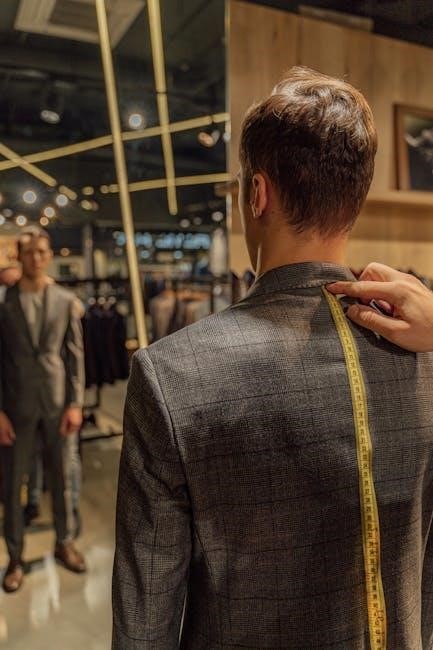
Chore coats and field jackets offer practicality with a rugged aesthetic. Chore coats, often made from durable cotton twill, feature a slim fit while maintaining traditional construction. Field jackets are designed with multiple pockets for functionality, reflecting their military origins. Both styles emphasize a relaxed yet structured fit, allowing ease of movement. They are versatile, suitable for casual or layered outfits, and pair well with jeans and boots for a laid-back look. Their timeless design makes them a staple in any wardrobe, blending utility with effortless style.
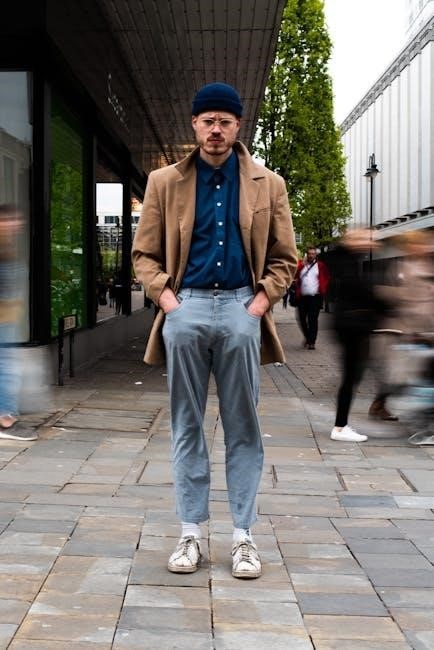
Fabric and Weight Considerations
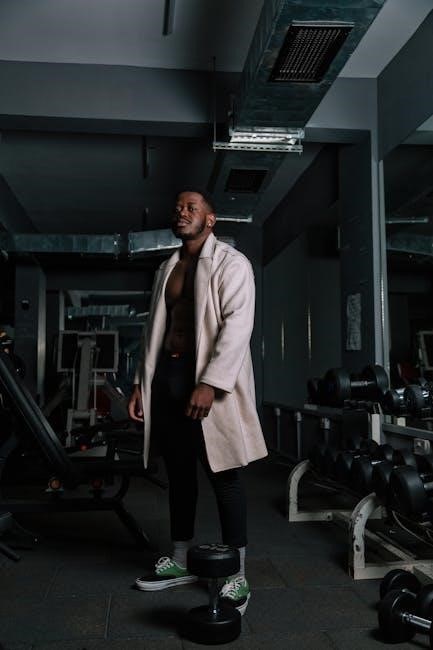
Fabric choice impacts both style and functionality. Natural fibers like wool and cotton offer insulation and breathability, while synthetic materials provide durability and moisture resistance, ensuring versatility for any season.
Seasonal Fabrics
Winter coats often feature heavy, insulating fabrics like wool, cashmere, or down-filled options for warmth. Summer and spring coats may use lighter materials such as cotton, linen, or nylon for breathability. Hybrid fabrics like wool-synthetic blends offer versatility across seasons. Natural fibers provide breathability and insulation, while synthetic materials enhance durability and water resistance. Layering compatibility is key, ensuring the coat complements underlying pieces without restricting movement. Choosing the right fabric ensures both comfort and style, catering to varying weather conditions and personal preferences.
Natural vs. Synthetic Insulation
Natural insulation, such as down or wool, offers exceptional warmth and breathability, making it ideal for cold, dry conditions. Synthetic insulation, like polyester or Thinsulate, provides durability, water resistance, and consistent warmth even when wet. Natural options are lightweight but require careful maintenance, while synthetics are easier to care for and often more affordable. Choosing between them depends on climate, activity level, and personal preferences, ensuring the coat performs well in its intended environment while maintaining comfort and style.
Fit Details to Focus On
A well-fitting coat should sit comfortably on the shoulders, with sleeves reaching the wrist and a body that aligns smoothly, ensuring a polished, proportionate appearance.
Shoulder Fit
The shoulder fit is a critical aspect of a well-tailored coat. It should sit comfortably, neither too tight nor too loose, ensuring freedom of movement. The coat’s shoulder pads should align with your natural shoulder line, avoiding any slouching or bunching. Proper shoulder fit ensures the entire garment drapes correctly, maintaining a balanced and polished appearance. Always measure your shoulders accurately and compare with size charts to achieve the perfect fit that complements your physique and enhances your overall style.
Sleeve Length and Fit
Sleeve length is essential for a polished look. Sleeves should reach your wrist when arms are slightly bent, ensuring cuffs peek out from gloves. Proper fit allows freedom of movement without restriction. Measure from the center back of your neck to your wrist for accuracy. Avoid sleeves that are too long or short, as this disrupts proportions. Opt for a tailored fit to ensure sleeves complement your body shape and coat style, balancing comfort and aesthetics seamlessly.
Body and Chest Fit
A well-fitted coat should skim your body without feeling restrictive. The chest area should fit snugly, allowing room for a shirt or sweater underneath. Ensure the coat buttons comfortably without strain, indicating a proper fit. The fabric should drape smoothly across your torso, avoiding bulkiness. For broader builds, look for styles with a bit more structure to maintain balance. A tailored fit ensures the coat complements your physique, providing both comfort and a polished appearance. Proper chest and body fit is key to a coat’s overall flattering silhouette.
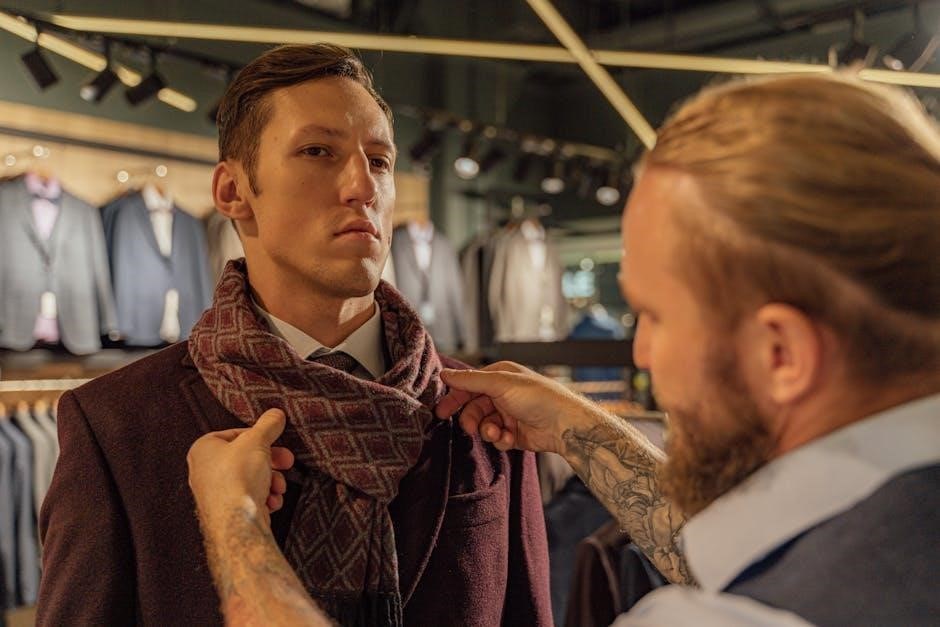
Coat Length and Proportions
Coat length should complement your height, with shorter styles for shorter men and longer coats for taller builds. Proportions must balance seamlessly with your physique for a polished, tailored look.
Height and Coat Length
Coat length should align with your height for a balanced look. Shorter men (under 5’7″) benefit from coats hitting just below the hips, while average height men (5’7″-5’11”) can opt for mid-thigh lengths. Taller men (over 6′) look best in coats reaching just above the knee. Proportions are key to ensuring the coat complements your frame without overwhelming it. Always choose a length that allows freedom of movement and maintains a polished, tailored appearance.
Waist and Hem Details
The waist and hem of a coat play a crucial role in its overall fit and functionality. A well-defined waist ensures a tailored look, while the hem should align proportionally with the coat’s length and your height. For shorter coats, the hem should hit just below the hips, while longer styles can extend to the mid-thigh or knee. Styling elements like buttons, belts, or adjustable tabs at the waist can enhance fit and aesthetics. Ensure the hem lies smoothly, avoiding bulk, to maintain a streamlined silhouette and balance the coat’s proportions effectively.
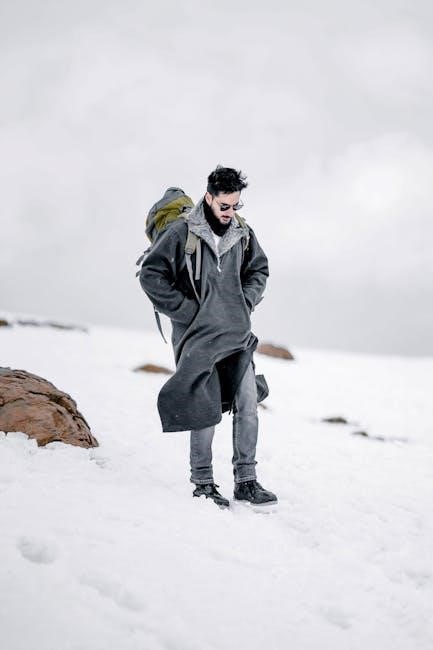
Additional Styling Tips
Accessorize with scarves, hats, and gloves to elevate your coat’s style. Coordinate with tailored trousers or jeans for a polished look. A well-fitting coat makes a statement, blending practicality with sophistication effortlessly.
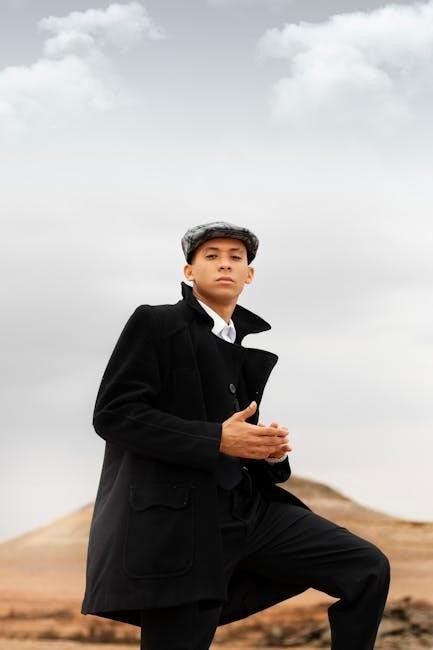
Accessorizing Your Coat
Accessorizing your coat can elevate its style and functionality. A scarf adds warmth and texture, while a hat and gloves complement the overall look. Consider the coat’s fabric and color when choosing accessories. A leather belt or brooch can add a touch of sophistication. Ensure accessories are proportionate to your build and coat size. Layering a patterned scarf under a solid-colored coat creates visual interest. Avoid over-accessorizing—focus on timeless pieces that enhance, not overwhelm, your coat’s design.
Coordinating with Other Pieces
Coordinating your coat with other pieces ensures a polished look. Pair slim-fit coats with tailored trousers or dark jeans for a sleek appearance. For casual styles, match with chinos or rugged boots. Consider the coat’s color and fabric when selecting shirts and sweaters. Neutral tones like navy, gray, or camel are versatile and pair well with most outfits. Ensure footwear complements the coat’s length and style. Bold patterns or bright colors require simpler, neutral pieces to avoid clashing. Balance proportions to create a cohesive, stylish ensemble.
A well-fitting coat elevates your style and confidence. Focus on proper measurements, fabric quality, and coordination with other pieces for a polished, versatile wardrobe essential.
Final Tips for the Perfect Fit
Ensure the coat’s shoulders align with yours, sleeves reach your wrists, and the length complements your height. Opt for breathable fabrics like wool or cotton for comfort. Consider tailoring for precision, especially if off-the-rack coats don’t fit perfectly. Pair your coat with outfits that match its style—casual or formal. Lastly, test the coat with your typical layering to guarantee ease of movement and a polished look. A well-fitting coat transforms your wardrobe and boosts confidence effortlessly.
